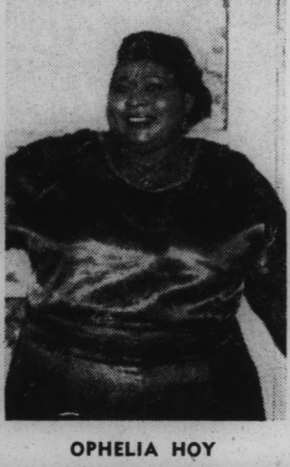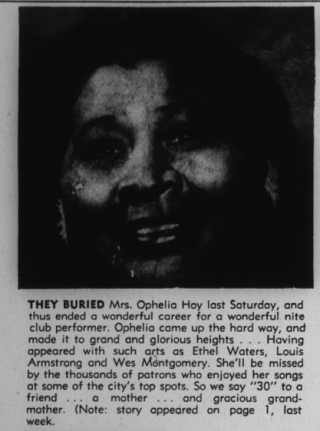
Jim Lingenfelter Collection – The Indiana Album – 1955
Cultural Cannibals is sponsoring a GoFundMe campaign to raise money to purchase a gravestone for Ophelia Hoy, click here to contribute.
“Even though she laughed and smiled when she sung those songs, behind the smile you could see a lot of sadness.” – Howard Pipes on Ophelia Hoy, as quoted in David Williams’ Indianapolis Jazz.
For four decades the vocalist Ophelia Hoy (11/05/1916 – 08/15/1968) was a fixture of the Indianapolis music scene. Ophelia rose to prominence as a blues singer on Indiana Avenue during the late 1930s, but she’d go on to hold down residencies at nightclubs across the city – from the Mayfair Tavern on the Eastside, to the Town & County lounge up north.
Ophelia remained a popular nightclub act in Naptown until her untimely death in 1968. But life as an artist can be rough, and according to accounts from Ophelia’s friends, the singer was living in poverty during the final years of her life. It’s been 50 years since Ophelia passed, and to this day her grave at Floral Park Cemetery remains unmarked.
I started this Go Fund Me campaign to raise money to purchase a headstone for Ophelia Hoy’s grave with the hope of bringing dignity and greater recognition to the legacy of this important figure in Indianapolis music.

Indianapolis Recorder – 1952
Unfortunately, Ophelia Hoy never made any commercial recordings. My understanding of Ophelia’s unique artistry is limited to historical accounts of her life. According to reports in the Indianapolis Recorder and Indianapolis Star, Ophelia performed with a wide range of music luminaries – including Ethel Waters, Louis Armstrong, and Wes Montgomery. Ophelia’s name also pops up in the early history of guitar icon Jimi Hendrix. In 1962 Hendrix traveled to Indianapolis on an offer to back Ophelia at a Downtown Indy club called the Brass Rail. Bassist Billy Cox was a member of Hendrix’s band at the time, he later recalled the experience during an interview:
“Jimi and I had been playing together for up to that point, maybe a year and a half together and-ah, we were out of the army. At that particular time we had a place in Clarksville and we came to-ah, Indianapolis because a fellow had told us that he worked-ah, here at the Brass Rail and any time we were in town – he said that he thought we were a good band – he’d like for us to come and he’d hire us. We were to play in the house band backing Ophelia Hoy, a bawdy blues singer.” But after arriving in Indy, Hendrix and crew were denied the job.
Perhaps the most important collaboration of Ophelia’s career was her partnership with the legendary blues pianist “Champion” Jack Dupree. Ophelia and Dupree performed together around 1940 at Naptown’s legendary Cotton Club. Ophelia was an incredibly popular blues vocalist in Indianapolis throughout the ’30s and ‘40s, frequently earning top votes in the Indianapolis Recorder’s annual music poll.

Ophelia Hoy’s obituary in the Indianapolis Recorder – 1968
Outside of her work as an entertainer there is little biographical documentation of Ophelia’s life. Writer David Williams collected the following information in his essential 2014 book Indianapolis Jazz:
“Ophelia Hoy was born on November 5, 1916 in Macon, Georgia. As a child she worked as a domestic for a wealthy white family who treated her badly. From this traumatic experience she developed an intense hatred of whites. In the early 1930s, she moved to Indianapolis and obtained a job at the Indiana State Fair singing popular blues songs. As longtime Indianapolis resident Howard Pipes remembered, ‘I saw Ophelia in the 1930s at the fair sitting on a bandwagon wearing a soiled white dress singing these lively, comical songs. Even though she laughed and smiled when she sung those songs, behind the smile you could see a lot of sadness.’ ”

1962 advertisement
Williams’ also comments on the often demeaning treatment Ophelia received from white club owners during the 1950s and 1960s:
“At the Playhouse Bar, Town and Country Lounge, and the Brass Rail, which were white establishments, she would dress like a Mammy type, with a polka-dotted bandana on her head, and sing risqué songs to the delight of the raucous audiences… According to performer Flo Garvin, the club’s owners insisted that Hoy don the costume and assume the obedient maid persona while she sang the bawdy songs. However, Hoy was an extremely proud woman who loved and respected Indiana Avenue, and her people, but she needed to earn a living. Sadly in her last days on earth, Hoy was a recipient of welfare and died on August 15, 1968 at Marion County General Hospital.”
Ophelia Hoy’s legacy in Indianapolis music is in dire need of restoration. Your contribution to this fundraising campaign is an important part of this process. Thanks for your time and consideration.

Indianapolis Recorder – 1949